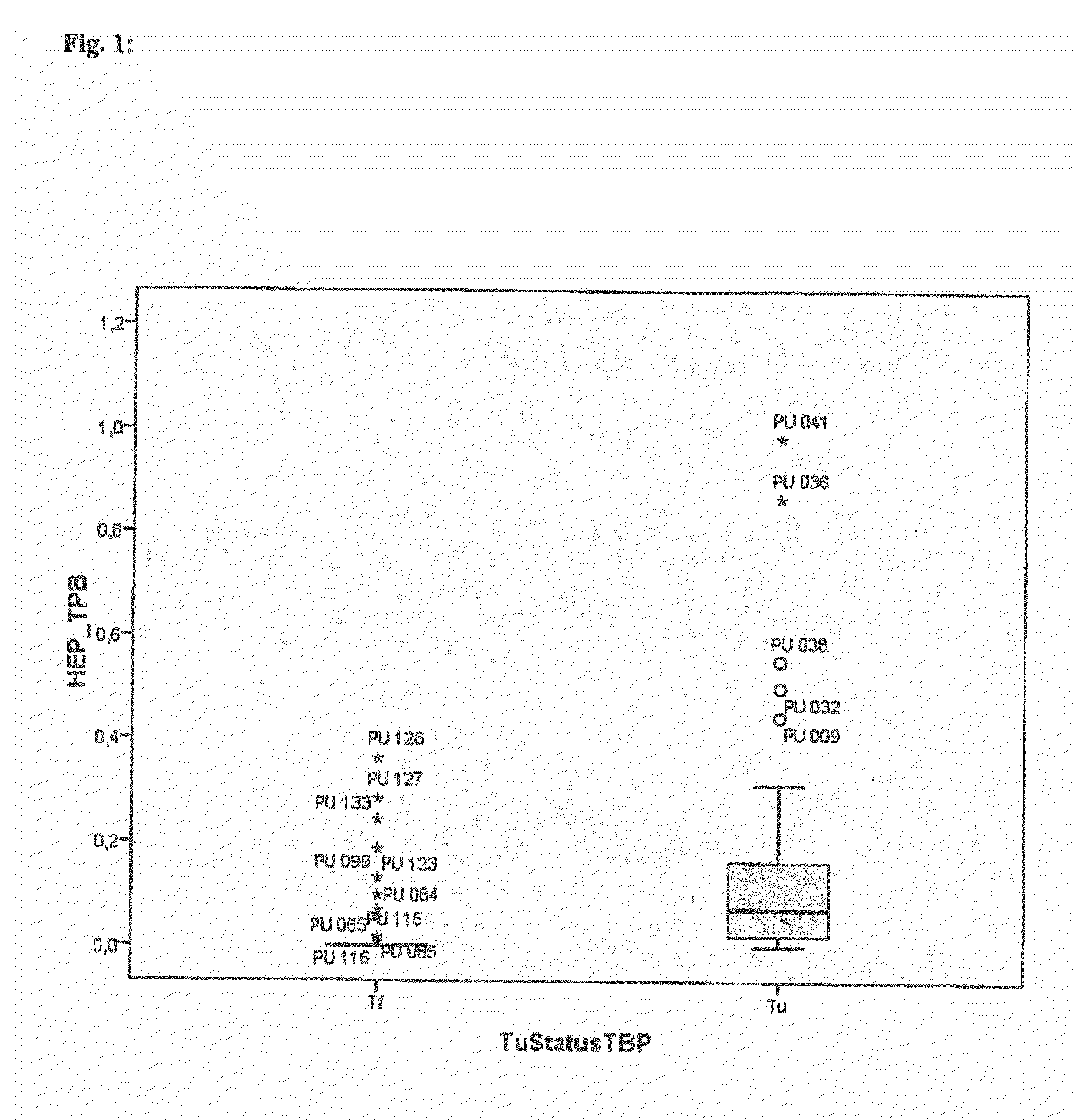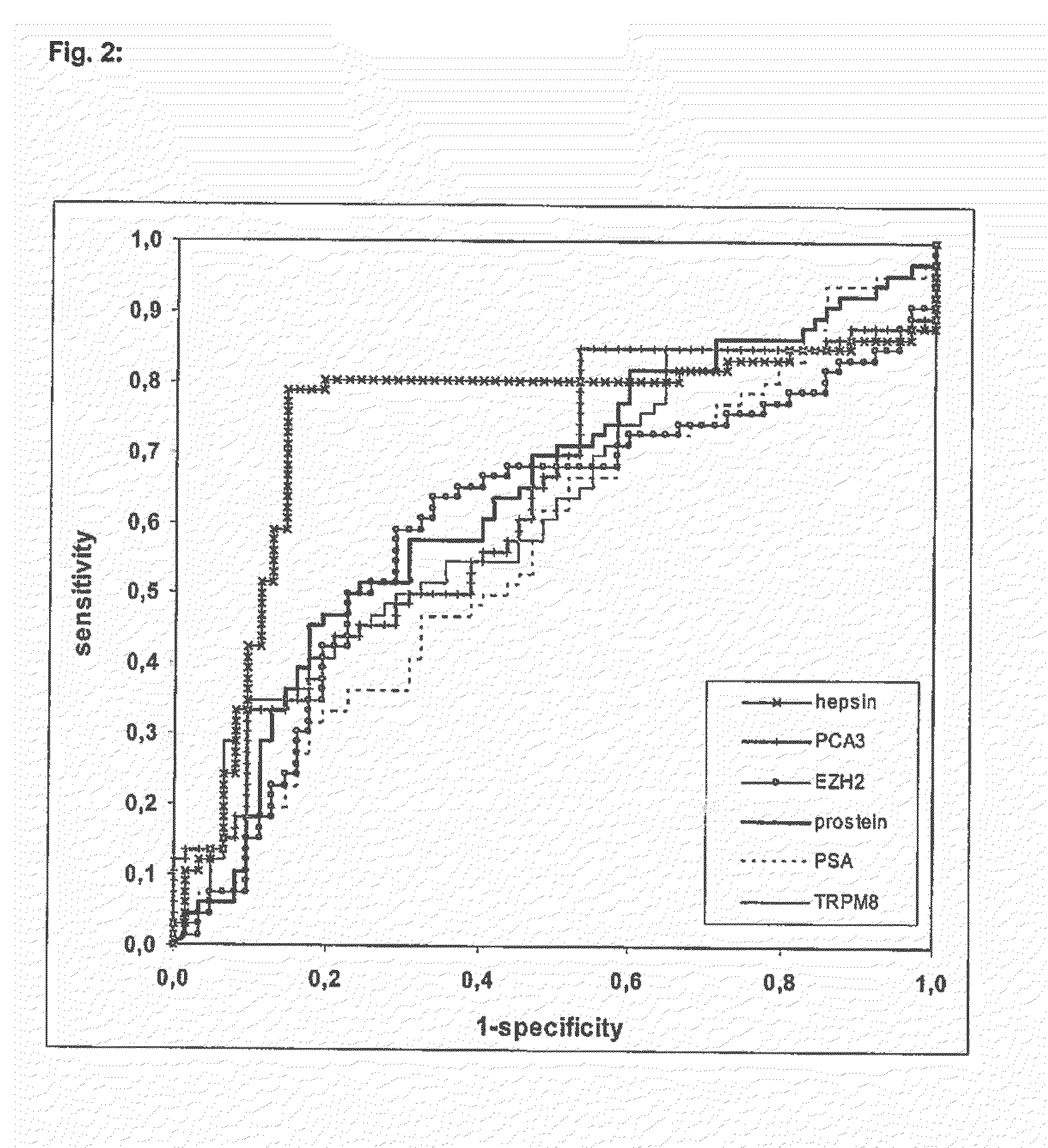Non-invasive method for diagnosis of prostate cancer
a prostate cancer and non-invasive technology, applied in combinational chemistry, biochemistry apparatus and processes, library screening, etc., can solve problems such as pain, cancer cells may metastatically spread, and difficulty in urination, and achieve the effects of reducing the risk of cancer, and reducing the risk of prostate cancer
- Summary
- Abstract
- Description
- Claims
- Application Information
AI Technical Summary
Benefits of technology
Problems solved by technology
Method used
Image
Examples
example 1
Comparison of the Relative Expression Levels (Average and Median) Between Patients with (Tu) and without (Ti) Prostate Cancer (as Tu / Tf Ratios)
[0067]For each prostate-associated transcript marker (normalized to the reference gene TBP) the values for the averages, medians and standard deviations (SD) as well as the bounds of evidence in the tumor (Tu) group and the tumor-free (Tf) group are given. To reflect the degree of up- or down-regulation of the respective marker in the Tu group, the ratios of the relative expression levels in the urine samples form prostate cancer patients and from patients without evidence of prostate cancer were calculated by division of the average or median levels per group. The Mann-Whitney U-test was used for statistical calculation whether expression levels of the markers are significantly different between the Tu group and the Tf group. Resulted values equal zero are substituted by a value at the bound of evidence.
TABLE 2Comparison of the relative expr...
example 2
Thresholds for the Relative Expression Levels of Different Marker Genes Normalized to TBP and Predictive Values for Exemplified Pre-Test Probabilities, Likelihood Ratios and AUC Values
[0069]Table 3 gives the regression coefficients and their statistical characteristics for the logistic model which predicts the probability of tumor, and an example for the calculation for an exemplary patient.
TABLE 3Final logistic regression model using four genes, and computation of certainty ofdiagnosis for a exemplary patientexemplarycontribution toRegressionstandardvalue ofthe logitVariablecoefficienterrorp-valuea patientof the patientIntercept2.82792.19060.19672.8279(PCA 3 / TBP)1 / 33.07260.87110.00040.2453.0726 * 0.2451 / 3 =1.9226(EZH2 / TBP)1 / 2−3.74181.08560.00062.047−3.7418 * 2.0471 / 2 = −5.3535(EZH2 / TBP)3 * 10−37.33172.41660.00247.3317 * 2.0473 * 10−3 =0.0629(EZH2 / TBP)−1 / 3−1.13070.58490.0532−1.1307 * 2.047−1 / 3 = −0.8905(prostein / TBP)−1 / 32.26380.70260.00131.1082.2638 * 1.108−1 / 3 =2.1877(prostein / TBP)...
example 3
Thresholds for the Relative Expression Levels of Different Marker Genes Normalized to TBP and Predictive Values for Exemplified Pre-Test Probabilities, Likelihood Ratios and AUC Values
[0070]The given thresholds in Table 4 are selected for maximal LR+ in the data of the diagnostic study. The positive predictive values (ppv) gives the certainty of diagnosis “tumor” in the ease of test positive result, and the negative predictive value (npv) gives the certainty of diagnosis “no tumor” in the case of test negative result for 3 different pretest values corresponding to 3 different case mixes in the clinical situation. LR+ is the factor for the increase of the pretest odds for the diagnosis “tumor” in the case of a test positive result, and LR− is the inverse of the factor for the increase of the pretest odds for the diagnosis “no tumor” in the case of a test negative result. The AUC of the ROC estimates the rate of right diagnoses independently of the threshold for the test positive meas...
PUM
| Property | Measurement | Unit |
|---|---|---|
| Fraction | aaaaa | aaaaa |
| Fraction | aaaaa | aaaaa |
| Fraction | aaaaa | aaaaa |
Abstract
Description
Claims
Application Information
 Login to View More
Login to View More - R&D
- Intellectual Property
- Life Sciences
- Materials
- Tech Scout
- Unparalleled Data Quality
- Higher Quality Content
- 60% Fewer Hallucinations
Browse by: Latest US Patents, China's latest patents, Technical Efficacy Thesaurus, Application Domain, Technology Topic, Popular Technical Reports.
© 2025 PatSnap. All rights reserved.Legal|Privacy policy|Modern Slavery Act Transparency Statement|Sitemap|About US| Contact US: help@patsnap.com



